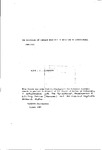THE DISPERSAL OF CABBAGE ROOT FLY IN RELATION TO AGRICULTURAL PRACTICE
| dc.contributor.author | ALEXANDER, KIRK I. | |
| dc.contributor.other | Faculty of Science and Engineering | en_US |
| dc.date.accessioned | 2013-10-31T12:39:15Z | |
| dc.date.available | 2013-10-31T12:39:15Z | |
| dc.date.issued | 1983 | |
| dc.identifier | NOT AVAILABLE | en_US |
| dc.identifier.uri | http://hdl.handle.net/10026.1/2508 | |
| dc.description.abstract |
The study aimed to estimate the dispersal rate of wild cabbage root flies in agricultural systems, to test a migration hypothesis and the predictions of a computer simulation model. The dispersal rate was determined by a new method, from the age-grouping of wild flies instead of releasing marked culture flies. The mean distance dispersed was calculated from-the slope of density of captured flies on distance; the mean age was calculated from laboratory measurements of development at constant temperatures. A new method of male age determination was developed, based on the changes in pupal fat and testes colour. The published method of female age determination was improved to allow more rapid separation of nulliparous and parous flies. The values of the slope and intercept fitted to the-density- distance data were strongly correlated. A computer simulation demonstrated that random noise causes a progressive underestimation of the slope, as the catch decreases. The slope for gravid females reaches a limiting value of approxiamately 0.2, indicating a mean distance dispersed of 500m. A numerical integration suggests that 95% of the flies move less than 580m. There was no evidence of the female migratory phase, proposed by Finch & Skinner(1975), which was probably an artefact of the use of ANCS attractant. The dispersal rate was estimated at 49-165 m/day, compared with 29-87 m/day predicted by the simulation model. There was little evidence that dispersal alters with agricultural practice. A proportion of the first generation were found to delay emergence on one site, which may be connected with the planting of fodder brassica crops at midsummer. | en_US |
| dc.description.sponsorship | The Agricultural, Development & Advisory Service (Starcross) and The National Vegetable Research Station | en_US |
| dc.language.iso | en | en_US |
| dc.publisher | University of Plymouth | en_US |
| dc.title | THE DISPERSAL OF CABBAGE ROOT FLY IN RELATION TO AGRICULTURAL PRACTICE | en_US |
| dc.type | Thesis | |
| plymouth.version | Full version: final and full version as approved by the examiners at the time of the award of your degree | en_US |
| dc.identifier.doi | http://dx.doi.org/10.24382/3401 |
Files in this item
This item appears in the following Collection(s)
-
01 Research Theses Main Collection
Research Theses Main


